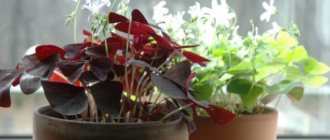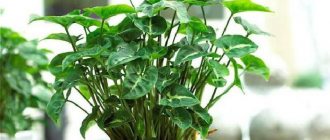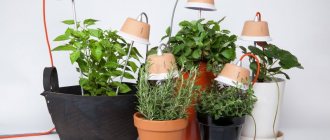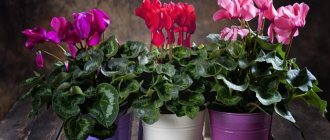Author: Elena N. https://floristics.info/ru/index.php?option=com_contact&view=contact&id=19 Category: Houseplants Published: June 22, 2017Last edits: January 11, 2021
- Cuttings
- Pests and their control
- Hatiora salicornioides
Hatiora (lat. Hatiora) is a genus of epiphytic cacti from the tropical forests of Brazil, numbering, according to various sources, from five to ten species, some of which are grown indoors. Some taxonomists include Hatiora in the genus Rhipsalis. At first, the genus was named “Hariota” in honor of Thomas Harriot, a famous English mathematician and traveler who was one of the first explorers of the nature of America. But then it turned out that this name had already been assigned to another plant, and it was necessary to use an anagram: chariota - hatiora.
Planting and caring for hatiora
- Flowering: April or May with terminal flowers of red, yellow or pink.
- Lighting: bright sunlight, on southern windowsills - with shading in the afternoon.
- Temperature: in the warm season – 18-25 ˚C, in winter – 12-14 ˚C. The difference between day and night temperatures should be 5-6 degrees.
- Watering: moderate: between two waterings the top layer of the substrate should dry out. During the dormant period, the substrate is moistened less frequently - approximately once every 3 weeks. Half an hour after watering, be sure to drain excess water from the pan.
- Air humidity: does not matter: hathiora is a succulent.
- Feeding: from spring to autumn 2 times a month with complex mineral fertilizers that do not contain calcium and with a reduced amount of nitrogen. In other months, no fertilizing is applied.
- Rest period: not clearly expressed.
- Pruning: to maintain decorativeness, excess segments are plucked off by hand in early spring.
- Replanting: in spring, after flowering, at a young age - annually, in maturity - once every two to three years, and large specimens - once every five years.
- Reproduction: cuttings and grafting.
- Pests: scale insects, mealybugs and spider mites.
- Diseases: stem rot, late blight.
Read more about growing hatiora below.
How to propagate the Hatiora salina cactus
This flower can be propagated using cuttings (stem segments). Take cuttings from the mother plant after flowering or in late spring. After separating the cuttings, let them dry for 24 hours. Place them carefully in moist soil (use a substrate rich in peat and sand) and roots should appear within four to six weeks.
The pots should be placed in a shaded place, and the substrate should be kept slightly moist. After a few months, you can begin to pluck the ends of the stems so that new plants begin to branch.
Hatiora can also be propagated by seeds, but this method is rarely used.
You can learn more about the propagation of this plant from this video
Botanical description
Hatiora cactus is a shrub with jointed stems. In some species of the genus, the segments are club-shaped, in others they are cylindrical or flat. What is the difference between hatiora and rhipsalis? Under natural conditions, the succulent hatiora grows in rock crevices and on stones, while the epiphyte rhipsalis prefers to settle in trees. Their external difference lies in the direction of growth of the stems: in hatiora they rise upward, while in rhipsalis the shoots droop. In addition, in hatiora the flowers are apical, pink, red or yellow, while in rhipsalis they are located along the entire length of the stem segment and are colored white or yellowish-white. In general, these plants are very close relatives and require the same conditions.
Exotic plant diseases
Most often, hatiora is attacked by pests such as:
- mealyworm (segments become covered with white spots);
- spider mite (yellow dots);
- scale insect (yellowing of segments);
- whitefly (depleted type of crown).
To combat pests, use a hot shower, when the plant is doused with a diffuse stream of water (40 degrees), a soap solution made from laundry soap, which is used to wash the stems.
When these methods are insufficient, insecticides such as Aktara, Confidor and others are used.
Hatiora is also susceptible to bacterial infection. It appears as wet, slippery spots on the stems. The affected segments should be broken off immediately, and the entire plant should be treated with an antibacterial drug. If the condition of the plant does not improve, then the only thing left is to use healthy segments to grow a new bush and destroy the affected flower.
If the hatiora has been affected by fungal diseases, then it must be treated with fungicidal preparations.
Caring for hatiora at home
Growing conditions
Caring for hatiora is easy. But first you need to find a decent place for it in the house. The hatiora plant will feel great on the windowsills of windows facing south, but the plant must be shaded from direct sunlight.
The main condition for good growth and development of hatiora is a noticeable difference between day and night temperatures. Hatiora is comfortable at 18-25 ºC. In the summer, it is advisable to arrange it on a balcony, terrace or in the yard, in the shade of a tree. In winter, in the room where the hatiora flower grows, the temperature should be within 12-14 ºC: it is at this time and in such conditions that the formation of flower buds occurs. Hatiora blooms in April or May.
- Ivy at home, types and varieties
Do not forget to ventilate the room where the plant is located, and in the hot season it must be sprayed, sometimes even twice a day: dry air makes the hatiora stems wrinkle and wither.
Pruning hatiora, or rather, forming hatiora, is done manually: excess segments are simply “unscrewed” from the stem.
Watering
Water the hathiora with settled or filtered water at room temperature when the top layer of soil in the pot dries. During the dormant period, watering is carried out less frequently: approximately once every three weeks. Half an hour after watering, be sure to drain excess water from the pan. From excess moisture and from watering with cold water, the plant can develop root rot.
Top dressing
During the period of flowering and active growth, the indoor hatiora flower needs to be fed with mineral fertilizer that does not contain calcium and with a small amount of nitrogen. The ratio of macroelements should be as follows: nitrogen - 9, phosphorus - 18, potassium - 24. Application frequency - 2 times a month. In a dormant state, the plant does not need fertilizing.
Transfer
Young plants need annual replanting, mature plants need to be replanted once every two years, and large ones - once every five years. Hatiora is transplanted in the spring, after flowering, into a substrate consisting of two parts of leaf soil, one part of coarse sand, one part of turf soil and one part of peat with the addition of charcoal. The soil mixture must be neutral or slightly acidic. The hatiora pot needs to be shallow. A layer of drainage material is placed at its bottom, then a small layer of substrate, onto which the hatioru is transferred from an old pot. Then the space of the new pot is filled with soil mixture, the surface is lightly pressed and watered.
How to propagate and replant an indoor flower
The main type of propagation of indoor flowers is cuttings by segments. It should be remembered that the segments that are to be cut should be torn off from the shoot manually, as if twisting, without using any tools.
Let's consider a step-by-step algorithm for rooting cuttings:
- Break off a selected cutting with several lobes (2-3) from an adult plant.
- The base of the broken cutting must be dried and treated with crushed coal.
- Prepare a peat-sand mixture and plant cuttings in it for rooting.
- Water the planted material moderately.
- Place the containers with the planted cuttings in a greenhouse in which to maintain the temperature from 20 to 24 degrees, while regularly ventilating.
- After rooting for a month, the young plant is planted in a permanent flowerpot.
Cuttings
Sometimes cuttings are placed in containers with water, having previously been treated with Kornevin’s solution. After a while they sprout roots.
Another way to propagate perennials is to sow seeds for seedlings. However, for this method to produce results, it is necessary to have experience in breeding activities. Seeds are sown very quickly in a moist soil mixture so as not to lose germination. After sowing, a certain temperature (+20-25 degrees) and humidity in the greenhouse are constantly maintained.
Important!
Bottom heating of the soil is necessary. The process of seed growth is very long and painstaking. After the seedlings have germinated, they are moved to a bright place without removing the shelter. And after 3 weeks they begin to accustom the young plant to the environment. The germination rate of plants from seeds is low, so this method of cactus propagation is complex and not always suitable for amateur gardeners.
Hachiora Reproduction
Cuttings
Hatiora is easily propagated at home by cuttings, and each broken stem segment is a potential cutting, which can itself take root directly in the mother pot. If you want to propagate hatiora, after flowering, break off a piece of 3-4 segments from its stem, sprinkle the wound with crushed coal, dry the cutting for 3-5 days, then powder the lower edge with Kornevin and plant the cutting in a damp substrate for cacti. Water the cuttings through a tray and only after the substrate has completely dried. The next year, with proper care, a flowering bush will form from the cuttings.
- Homemade hyacinth: planting, forcing, growing
Hachiora grafting
Hatiora is grafted onto Perescia spinosa. Hatiora propagation by grafting is carried out in the summer by removing the branched part of the rootstock and splitting its trunk. The lower end of the Hatiora scion cutting with 2-3 segments is sharpened with a wedge and inserted into a split in the Pereskia trunk, after which the grafting site is fixed with a plaster. The bandage is removed only after the scion begins to grow. At a temperature of 18-20 ºC this can happen in 2-3 weeks. Shoots appearing below the grafting site are removed. Grafted hatiora bloom especially profusely.
As you can see, breeding hatiora and caring for it are simple and easy.
general information
Hathiora lives in tropical forests and, in fact, leads a terrestrial lifestyle. It has very superficial fibrous roots, and aerial roots form between the shoot segments. Due to this, she manages to receive moisture and nutrients from literally all sides.
Hatiora grows slowly, and at home it rarely exceeds 30-40 cm. But old healthy specimens, which are already 10 years old or more, can grow up to 1.8 m. As they grow, the shoots stretch upward, but over time they droop under their weight .
The green shoots of hatiora consist of pot-bellied cylindrical segments, which can also swell when moisture accumulates. Old shoots gradually become darker. Some have white dots visible on them - all that remains of the spines of the former cactus.
Hathiora blooms with the same unusual tubular flowers at the end of the stems. They are usually yellow or pink, and after a couple of weeks they gradually wither and berries form in their place.
Photo: apriltime.ru
Diseases and pests
Pests and their control
Hatiora can be affected by scale insects, mealybugs and spider mites. All these insects are sucking: they make bites in the stems of the hatiora and feed on its cell sap. To combat these pests, the plant is treated three times with an acaricide solution, for example, Fitoverma, Akarina or Agravertina, but the top layer of soil in the pot is first replaced.
Diseases and their treatment
From chronic waterlogging, the root system of hatiora can be affected by rot, which causes the stem to soften and turn brown. If this happens, then the plant cannot be saved. The best thing you can do is root the healthy parts of the stems.
Hatiora can also get late blight. In this case, the stems of the plant lose color, turn gray, become limp and rot. Timely treatment with Oxychom can save the plant.
Why does hatiora not bloom?
If the hatiora does not bloom or produces too few buds, there may be two reasons. First: the pot is too small for the plant. Second: improper maintenance of the plant during the dormant period, as a result of which the hatiora failed to lay flower buds in the required quantity. We remind you: the hatiora must winter in a temperature not lower than 10 and not higher than 16 ºC, without fertilizing and with minimal watering.
Why does it turn yellow?
Hatiora stems turn yellow due to excessive watering or pest damage. Carefully examine the plant, determine the cause of its ill health and eliminate it before it is too late.
- Croton: care, reproduction, types
Possible problems and solutions
Hatiora is not picky and problems with its cultivation are rare. Why does it sometimes become lethargic and not make flowers bloom? Most difficulties arise from improper care and non-compliance with periods of growth and rest.
Correcting care errors - table
| Problem | Causes | Solutions |
| The plant either does not bloom at all or has very few flowers. |
|
|
| Buds and entire segments fall off. |
|
|
| The segments shrink and wither, despite regular watering. |
| Move the pot with the plant to a cooler place and immediately begin regular spraying. |
| Light spots on stems. | Too bright light, direct sunlight. | Do not place the hatiora on south-facing windows or shade it during midday hours. |
| Branching too slow. | Lack of nutrients. | Regular feeding - every 2 weeks. |
| Rotting of the roots and lower part of the stem. |
|
|
Types and varieties
Of all the types of hatiora, the following are grown in indoor culture:
Hatiora salicornioides
Or Hatiora salicorniformes, or saltoria-like, or saltwort-like - the type species of the genus. The stems of this extremely branched plant, forming a tree about 40 cm high, unlike other types of hatiora, are round in cross-section, thin, consisting of pin-shaped segments, for which in England the plant received the nickname “drunkard’s dream”. In spring, Hathiora salosa blooms with small terminal pink, red or yellow bell-shaped flowers.
Hatiora rosea
It differs from the previous species in its green with a reddish tint by flat stems of elliptical or club-shaped shape. The flowers of this species are large, up to 3-4 cm in diameter, light pink.
Hatiora herminiae
Epiphytic cactus with crimson flowers and straight or arched stems up to 30 cm long, consisting of dark green, cylindrical segments from 2 to 5 cm long with a diameter of 5 mm.
Hatiora gaertneri
The stem segments of this plant, with small notches along the edges, reach a length of 7 cm. The flowers of Hatiora Gartner are funnel-shaped, scarlet-red, up to 5 cm in diameter.
Hatiora graeseri
A hybrid species between Hatiora rosea and Hatiora Gartner. The flower petals of this hybrid are colored in red-burgundy tones, but during the reclamation process other shades began to appear.
Five-winged Hatiora pentaptera
A plant with pentagonal stems and small white flowers, resembling a shrub.
Landing
It is enough to follow generally accepted rules and act carefully.
Hatiora is an unpretentious plant, so it does not need to meet specific requirements. Even a novice gardener can handle planting and replanting.
Choosing a pot
For young bushes, low pots with a diameter 2–3 cm larger than the earthen ball are suitable. You should not use containers that are too spacious, because the crown will not grow until the roots fill the pot. Sometimes weak plants cannot grow enough roots and die.
For adult short-growing specimens, wide, but not tall, flowerpots are suitable. Plants taller than 40 cm are best planted in heavy, stable containers.
The bottom of the pot must have drainage holes to drain excess moisture and a spacious tray.
Soil composition
Hatiora requires a nutritious, loose soil mixture that allows moisture to pass through well. The liquid should not stagnate at the roots, so it is better to avoid moisture-intensive soil mixtures.
Experienced gardeners advise using soil with slightly acidic or neutral properties. You can mix the substrate yourself or buy ready-made soil for succulents.
Composition (2:2:1: 1:1):
- turf land;
- leaf soil;
- humus;
- coarse river sand;
- peat;
- some brick chips or clay granules.
A drainage layer of fine expanded clay, pebbles or polystyrene must be poured onto the bottom.
Transfer
It is advisable to keep a flower bought in a store in old soil for about a week. This way the plant will get used to the microclimate of the room and will tolerate replanting more easily. Transport soil must be completely removed from the roots.
To remove excess soil, you need to dry the plant for three days. Then take out the bush along with the earthen lump and shake it lightly. The remaining soil can be washed off under the tap or the roots can be soaked for 10–15 minutes in a basin of water.
Young plants are replanted annually until the age of three. Hatioras from three to six years old are replanted once every 2-3 years; whiter adult specimens are recommended to be replanted once every five years.
Sometimes you have to change the pot a little more often, it all depends on the growing conditions and growth rate.
How to understand that a plant needs a transplant:
Recommended by topic
Polyscias Narcissus Orchid
- horses look above the surface of the ground;
- when replacing the top layer, it is clear that the roots have filled the entire pot;
- the roots stick out into the drainage holes;
- after watering, the moisture does not go deep into the soil for about 10 minutes;
- the soil dries out quickly and lags behind the walls of the pot.
In the intervals between transplants, it is recommended to annually replace the top layer of soil by 3–5 cm.
Hatiora is transplanted together with a lump of earth. To prevent the soil from falling off the roots, the plant is watered thoroughly 2-3 days before transplanting.
Transplant stages:
- a drainage layer of 1 to 5 cm is poured into the new pot, depending on the volume of the container;
- a little fertile soil is poured on top of it;
- the plant is removed from the old pot and transferred to a new one along with a lump of earth;
- install a bush in the middle and fill the voids with fresh soil;
- shake the pot a little so that the substrate fills all the free space well;
- water the hatiora and move the pot to its usual place.
If the plant is large and requires staking, it is better to install the support during replanting rather than after. You need to insert the stick carefully so as not to damage the delicate roots.
Varieties
There are three breeding varieties of Hatiora adapted for growing indoors.
| View | Description |
| Hatiora Hermina (Hariota herminiae lat.) | A stem or epiphytic plant with shoots of straight or slightly curved shape, no more than 30 cm high. Its internal stroma is dense and elastic, cylindrical shoots are about 50 mm, and the lateral buds of the areola are pubescent with spines and scattered along the entire length. The flowers are medium-sized, up to 3 centimeters in diameter, brightly colored lilac-pink. |
| Salicornioides Hatiora or saltwort (Hariota salicornioides Haw.) | Classic type of plant. In common parlance it has many interpretative names: “dancing bones”, “drunkard”, “little glass”, due to the peculiarity of the structure of the plant. The shoots consist of small (2-3 cm long) club-shaped or hodgepodge-shaped segments 0.5 cm thick. The shape of the plant is slightly broken. In the first phase of development, the stem shoots have an erect position, but as they grow they droop. The root stem gradually becomes woody. Hatiora hodgepodge blooms with yellow and orange small (0.3-1 cm) flowers. The flowering period lasts 2 months. |
| Hatiora pink (Hariota rosea Lat.) | A compact bush of small flattened-faceted segments measuring 2.5x1 cm bordered with reddish festoons. Its branches have a rich dark green color and a strongly drooping shape. The flowers are bright pink, large, more than 3.5 cm, blooming at the apex and at the joints - one of the differences between the ripsalidopsis Hatiora. |
The necessary conditions
Humidity
The plant requires moisture
Prefers high air humidity - 75-80%. In summer, irrigate every day with warm water from a spray bottle; on hot days, this procedure is carried out twice a day. Additionally, install an open container with water and place the flower pot on a tray with wet pebbles or expanded clay.
In the cold season, you can arrange daily ventilation of the room, because the plant does not like stagnant air. Before opening the window, it is better to take the hatiora into another room, because frequent drafts can cause it to wither and shed its stems.
Temperature
Throughout the entire growing season, the plant is provided with a temperature within 19-25°C. In summer, it can be kept on a terrace or balcony, where there is shading during the midday hours and there are no drafts. You can also place the flower in the garden under bushes or trees that create shade in the sun.
The laying of inflorescences occurs in the winter season. For this process to be successful, you need to lower the temperature to 12-14°C. Abundant flowering begins in late April or early May.
Lighting
This is a short-day plant - 3-4 hours of diffused lighting per day is enough. This condition must be ensured in the spring and summer. In autumn and winter, when buds begin to form, the flower can be placed in a place where the sun shines throughout the day. If this is not possible, you can use artificial lighting by installing the lamp at a distance of 50 cm from the crown.
Purchase and adaptation
You can purchase one of the varieties of hatiora described above at any flower shop. The price, depending on the type, varies from 250 to 850 rubles.
Buy grown specimens that have a well-developed root system and above-ground part. When choosing a flower for your home, carefully examine the crown - the stems and inflorescences should be fresh, juicy without blackening, reddish or yellow spots.
By lightly shaking it off, you can determine its freshness - healthy shoots do not break off or fall off. The substrate is slightly moistened, does not contain acidification and mold on the surface. Through the drainage holes you can see the roots - they are a uniform brown color without rotting.
After purchase, it takes some time to adapt to home conditions. He is quarantined for three weeks, then moved to a common room and placed among vegetation.
If the hatiora is infected with some kind of infection, it is treated with fungicides; if it is infected with parasites, it is sprayed with insecticides. Only a week after treatment is it moved to the windowsill with other flowers.
Signs and superstitions
This plant with an unusual appearance has received many names among the people - a drunkard's dream, men's tears, dancing bones.
Some flower growers do not risk growing it, because they believe that it can drive any man out of the house, or harm existing relationships - provoke misunderstandings, quarrels, scandals and divorce.
Other superstitions claim that hatiora helps identify an enemy who is visiting your home. Some time after he leaves, she blossoms. This is a sure sign that communication with such a person should be kept to a minimum.
The benefit of the flower is expressed in its ability to have a calming effect on all family members, to restore the former atmosphere and comfort. If you accept a flowering plant as a gift, peace and harmony will reign in your home.











